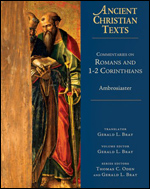What Did Ambrosiaster Believe About Head Covering?

[Series introduction: This post is part of a series that examines what certain leaders in church history believed about head covering. Their arguments, choice of language and conclusions should not be misconstrued as an endorsement from us. The purpose of this series is to faithfully show what they believed about covering rather than only selectively quoting the parts we agree with.]

Though we don’t know the identity of Ambrosiaster, his commentary gives us access into the mind and beliefs of a 4th century Christian theologian. We’re able to see that head covering had adherents and defenders from the early church and we can see how someone from that era understood Paul’s reasoning in the text. Since Ambrosiaster provides a line-by-line commentary of 1 Corinthians 11, we have a more complete picture of how he understood this doctrine.
First we see that Ambrosiaster was a complementarian. He understood that the structure of authority given in 1 Cor 11:3 did not indicate value or worth, but function. He said “Man is greater than she is by cause and order, not by substance”. The woman should not “be upset because of her state of subjection” and the man should not think “that he has some exalted position”.
He understood Paul’s word’s: “[man] is the image and glory of God; but woman is the glory of man” (1 Cor 11:7) to mean that man was uniquely made in the likeness of God. He said “a man is formed in the likeness of God and a woman is not. She is the likeness of God because of the man.” It is because the man uniquely bears the image of God that Ambrosiaster believes he cannot cover his head when praying or prophesying. He says, the “honor and dignity of a man makes it wrong for him to cover his head, because the image of God should not be hidden.”
If we take a look at that last statement one more time we also see he breaks away from his exegesis and indictates this teaching is his own.
“Paul says that the honor and dignity of a man makes it wrong for him to cover his head, because the image of God should not be hidden. Indeed, it ought not to be hidden, for the glory of God is seen in the man.”
The most natural reading of that paragraph is that he’s interpreting Paul in sentence one (Paul says..) and then he affirms it as his own view in the next sentence (Indeed…).
We also see this happen once more when he explains why women are to cover “because of the angels” (1 Cor 11:10). Here is Ambrosiaster’s full comments on that passage:
The veil signifies power, and the angels are bishops, as it says in the Revelation of John, where, because they are men, they are criticized for not rebuking the people, though good behavior on their part is also praised. A woman therefore ought to cover her head, because she is not the likeness of God but is under subjection. Because transgression began with her, she ought to indicate this by covering her head in church out of reverence for the bishop. Nor should she speak, because the bishop takes the place of Christ. In front of him, and because he is the representative of Christ, she ought to appear as she would before a judge, as one under subjection, because of the way the sin of which we are guilty originated.
In the bolded text Ambrosiaster is sharing with us his own view since he’s departed from commenting directly on the passage at hand. In it he brings up woman’s transgression (1 Tim 2:14) and the fact that she’s to be silent (1 Cor 14:34-35). He’s not interpreting the text as Paul delivered it but rather he’s pulling together various Scriptures from all over the Bible to show how he believes a woman should present herself in church.
Speaking of church, we also see from this passage that he believed the context of the command was the local church. He saw angels as the church elders/bishops and “out of reverence” to them she should “[cover] her head in church”. He also gives some examples of what a woman would be doing in the worship service. He says, “It is honorable and practically compulsory, for a woman to be veiled when making amends and giving thanks to God.”
He also gives further reasons for covering which include “agreement from nature, and what [Paul] says is right”. He saw a woman’s long hair as “symbolic of veiling” and the veil itself was a “voluntary addition to nature”. He concludes by saying “after giving reasons to refute dissenters, Paul lays down his authority…”. He said Jewish custom, Moses and Jesus “knew nothing of unveiled women…”. “This is why he says that neither he nor the churches of God [recognize any other practice].”
*All quotations are taken from “Commentaries on Romans and 1-2 Corinthians (Ancient Christian Texts)” (IVP Academic, 2009) – pages 171-173
*Bolding was done by the author of this article.
- The Head Covering Movement’s New Direction: A Call for Team Members - July 11, 2025
- Is Head Covering Related to Spiritual Gifts? A Response to Barry York - July 5, 2023
- A Husband’s Authority is Limited (He is Not Pastor or King) - November 14, 2022



